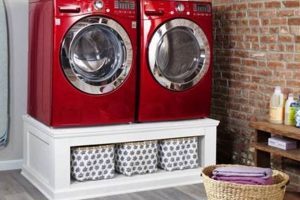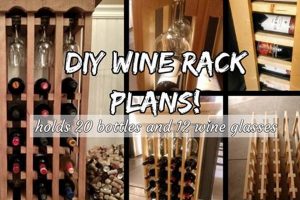The process of constructing a housing or border for a stretched artwork using readily available materials and tools, undertaken by the individual creator, is a form of artwork presentation and preservation. For example, one might utilize wood, measuring implements, cutting tools, and fasteners to create a structure that surrounds and protects a painting on a stretched surface.
This practice offers several advantages, including cost savings compared to professional services, customization options to perfectly complement the artwork, and the satisfaction of a hands-on creative endeavor. Historically, artists often built their own supports and enclosures, allowing for greater control over the final presentation and integration of the artwork with its intended environment.
The subsequent sections will detail the materials, tools, and techniques required to effectively and successfully create these supports, ensuring that the artwork is both aesthetically enhanced and structurally sound.
Essential Considerations for Creating a Canvas Frame
The following recommendations aim to optimize the process and final result of constructing a support for stretched artwork. Adherence to these guidelines can improve the longevity and aesthetic presentation of the finished piece.
Tip 1: Precise Measurement is Critical. Prior to any cutting, ensure accurate measurements of the canvas. Account for any desired reveal or overlap between the canvas and the frame edge. Inaccurate measurements can lead to ill-fitting supports, requiring rework or complete reconstruction.
Tip 2: Select Appropriate Wood. Opt for straight, knot-free lumber that is sufficiently rigid to support the canvas without warping. Softwoods, such as pine, are commonly used; however, hardwoods may offer greater stability for larger works.
Tip 3: Employ Accurate Cutting Techniques. Utilize a miter saw or similar precision tool to achieve clean, accurate cuts, particularly for mitered corners. Inconsistent angles or imprecise cuts compromise the structural integrity and aesthetic appearance of the finished support.
Tip 4: Prioritize Secure Joinery. Select a robust joinery method, such as mitered corners reinforced with wood glue and brad nails or screws. Ensure all joints are flush and securely fastened to prevent separation over time.
Tip 5: Sand All Surfaces. Prior to finishing, thoroughly sand all exposed wood surfaces to remove imperfections and create a smooth, even surface for painting or staining. This step enhances the aesthetic appeal and prevents splintering.
Tip 6: Consider a Protective Finish. Apply a sealant, stain, or paint to protect the wood from moisture and environmental factors. Choose a finish that complements the artwork and the surrounding dcor.
Tip 7: Utilize Appropriate Hardware. Employ D-rings, wire, or other appropriate hanging hardware rated to support the weight of the framed artwork. Ensure the hardware is securely attached to the support and properly positioned for balanced weight distribution.
Consistent application of these recommendations will increase the likelihood of producing a professional-quality support that enhances the artwork and provides lasting protection.
The concluding section will synthesize the information presented and offer final recommendations for successful completion of the project.
1. Accurate Measurement Crucial
The precision of dimensions is paramount in the successful execution of a self-constructed support for a stretched artwork. Inaccurate measurements introduce cumulative errors that compromise structural integrity, aesthetic quality, and the overall presentation of the artwork.
- Material Waste Reduction
Imprecise dimensions necessitate repeated cutting and adjustment, leading to significant material waste. A miscalculation, even a fraction of an inch, can render a piece of lumber unusable for its intended purpose, escalating project costs and contributing to resource depletion. Accurate measurements, conversely, optimize material usage, minimizing waste and conserving resources.
- Structural Stability Enhancement
A support constructed with inaccurate measurements exhibits compromised structural integrity. Gaps, misalignments, and uneven joints weaken the frame, rendering it susceptible to warping, sagging, or even complete failure. Precise measurements ensure tight, secure joints, distributing stress evenly throughout the frame and enhancing its overall stability.
- Aesthetic Harmony Maintenance
Dimensional inaccuracies detract from the aesthetic appeal of the framed artwork. Uneven reveals, skewed corners, and misaligned edges create a visually jarring effect, diminishing the perceived value and impact of the artwork. Accurate measurements ensure clean lines, consistent proportions, and a harmonious integration of the frame with the artwork, enhancing its visual presentation.
- Cost-Effective Project Execution
The expense associated with support creation escalates when inaccurate measurements lead to rework, material waste, and the need for specialized tools to correct errors. Meticulous measurement, using reliable tools and techniques, streamlines the construction process, minimizing the potential for costly mistakes and ensuring a more cost-effective project execution.
The ramifications of neglecting accurate measurement in the context of creating a support structure extend beyond mere inconvenience. It directly affects material efficiency, structural soundness, aesthetic appeal, and overall project cost. Therefore, meticulous attention to detail in measurement is not merely a best practice, but a fundamental requirement for achieving a professional and enduring result.
2. Appropriate Material Selection
The selection of suitable materials constitutes a critical juncture in the process of independently creating supports for stretched artworks. The inherent properties of chosen components directly influence structural integrity, longevity, and the ultimate aesthetic presentation of the artwork. Diligent consideration of material characteristics is, therefore, paramount.
- Wood Species and Stability
The species of wood employed significantly impacts the frame’s resistance to warping and distortion. Softwoods, such as pine, offer cost-effectiveness and ease of workability but exhibit greater susceptibility to environmental fluctuations. Hardwoods, like maple or oak, provide superior stability and resistance to deformation but entail higher costs and demand more specialized tools. The selection hinges on a balance between budgetary constraints and desired longevity.
- Material Moisture Content
The moisture content
of the lumber is a crucial factor affecting long-term stability. Wood with excessive moisture is prone to shrinking, warping, and promoting mold growth, compromising the structural integrity of the frame. Kiln-dried lumber, possessing a low and uniform moisture content, mitigates these risks, ensuring a stable and durable support. Failure to account for moisture content can result in costly repairs or replacements. - Fastener Selection and Compatibility
The choice of fasteners, such as screws, nails, or adhesives, must align with the chosen wood species and anticipated stress levels. Incompatible fasteners can cause splitting, weakening the joints, and compromising structural integrity. For example, using coarse-threaded screws in softwood can strip the wood fibers, leading to insecure connections. Matching fastener types to material properties is essential for durable assembly.
- Finishing Material Composition
The composition of finishing materials, including sealants, stains, and paints, influences both aesthetic appearance and protective properties. Certain finishes may react adversely with specific wood species or adhesives, causing discoloration, peeling, or delamination. Selecting compatible finishing materials, considering factors such as UV resistance and moisture permeability, ensures a lasting and visually appealing final product.
These facets underscore the inextricable link between judicious material selection and the successful, independent creation of supports. Neglecting these considerations can precipitate structural failures, aesthetic imperfections, and ultimately, necessitate costly remediation efforts. A comprehensive understanding of material properties and compatibility is, therefore, indispensable for achieving a durable and visually pleasing result.
3. Secure joinery methods
In the context of independently creating supports for stretched artworks, secure joinery methods represent a linchpin element. The stability and longevity of the entire structure depend directly upon the efficacy of the connections between individual components. Weak or improperly executed joints invite structural failure, rendering the frame susceptible to warping, separation, and ultimately, an inability to adequately support the artwork. This, in turn, compromises the aesthetic presentation and potentially jeopardizes the physical integrity of the canvas itself. A real-world example illustrates this point: A frame constructed with poorly executed miter joints, secured only with insufficient wood glue, may initially appear sound. However, seasonal changes in humidity can cause the wood to expand and contract, placing stress on the weak joints. Over time, this can lead to visible gaps, misalignment of corners, and a general weakening of the structure, necessitating costly repairs or complete replacement.
Several joinery techniques can be employed to achieve secure and lasting connections. Mitered corners, while aesthetically pleasing, require reinforcement to prevent separation. Options include the use of splines, which are thin pieces of wood inserted into slots cut into the mitered surfaces, providing a mechanical interlock. Alternatively, mortise and tenon joints, characterized by a projecting tenon that fits snugly into a corresponding mortise, offer exceptional strength and stability. Furthermore, the application of high-quality wood glue, specifically formulated for joint strength, is essential for creating a durable bond. The correct clamping pressure during glue application is also critical; insufficient pressure results in a weak bond, while excessive pressure can starve the joint of adhesive. Beyond the specific technique, the precision of the cuts and the accuracy of the assembly are vital factors in ensuring a secure and aesthetically pleasing result.
Ultimately, the selection of appropriate joinery methods constitutes a critical aspect of successful support structure creation. Careful consideration of the material properties, the intended load-bearing capacity, and the aesthetic requirements is paramount. While simpler joinery techniques may suffice for smaller, lightweight artworks, larger or more valuable canvases demand robust and well-executed connections to ensure long-term stability and preservation. A lack of attention to secure joinery undermines the entire undertaking, negating the benefits of careful material selection and precise measurement, highlighting its central role in the overall process.
4. Protective finishing application
The application of protective finishes to self-constructed supports for stretched artworks is inextricably linked to the long-term preservation and aesthetic maintenance of both the frame and the encased canvas. This step transcends mere aesthetic enhancement, serving as a crucial barrier against environmental factors that degrade the constituent materials. For example, untreated wood is susceptible to moisture absorption, leading to warping, fungal growth, and eventual structural failure. A properly applied finish, such as varnish or sealant, mitigates this risk by creating a hydrophobic layer that prevents water intrusion and inhibits biological decay. The absence of such protection represents a significant oversight in the fabrication process, potentially nullifying the benefits of meticulous measurement and secure joinery.
The selection of an appropriate finishing product must consider the specific wood species, the intended environment, and the desired aesthetic effect. Oil-based finishes, for instance, offer excellent penetration and water resistance but may yellow over time. Water-based finishes provide superior clarity and UV resistance but may require multiple coats to achieve adequate protection. A real-world scenario illustrating the importance of informed finish selection involves a support intended for display in a humid climate. The application of a non-waterproof finish would inevitably lead to moisture damage, potentially necessitating costly frame replacement and endangering the artwork. The protective finish also acts as a barrier against physical abrasion, reducing the risk of scratches and dents during handling and transport. This consideration is especially relevant for supports intended for frequent relocation or exhibition.
In summary, protective finishing application is a non-negotiable component of the self-directed frame creation process. It represents a proactive measure that safeguards against environmental degradation, enhances aesthetic appeal, and ultimately, extends the lifespan of both the frame and the artwork it contains. Overlooking this critical step introduces unnecessary risk and undermines the overall value proposition of constructing one’s own support. The prudent application of a suitable finish is an investment in the longevity and integrity of the artwork, reinforcing the importance of informed decision-making at every stage of the construction process.
5. Stable hanging hardware
The selection and implementation of stable hanging hardware constitutes an indispensable element within the realm of creating supports for stretched artworks. The secure and reliable suspension of framed artwork is param
ount for both aesthetic presentation and the prevention of potential damage. Inadequate or improperly installed hanging mechanisms introduce significant risks, potentially leading to falls, breakage, and irreparable harm to the artwork. Therefore, a thorough understanding of appropriate hardware and installation techniques is crucial.
- Weight Load Capacity
The primary consideration in selecting hanging hardware is its rated weight load capacity. This capacity must exceed the actual weight of the framed artwork, including the canvas, frame, and any added glazing or backing. Overloading hanging hardware creates a significant risk of failure, potentially resulting in a catastrophic fall. For instance, a D-ring rated for 20 pounds should not be used to hang a framed piece weighing 25 pounds. The weight rating should always include a safety margin.
- Hardware Material and Corrosion Resistance
The material composition of the hanging hardware directly impacts its durability and resistance to corrosion. Steel hardware, while strong, is susceptible to rust in humid environments. Brass or stainless-steel hardware offers superior corrosion resistance and is recommended for locations with high humidity or potential exposure to moisture. Corrosion weakens the hardware, reducing its load-bearing capacity and increasing the risk of failure. The choice of material must align with the environmental conditions.
- Attachment Method and Security
The method of attaching the hanging hardware to the frame is critical for ensuring a secure and stable connection. Screws are generally preferred over nails, as they provide a stronger and more reliable hold. The screws should be of sufficient length to penetrate deeply into the frame’s wood, and pilot holes should be drilled to prevent splitting. D-rings or strap hangers should be securely fastened to the frame’s vertical members, distributing the weight evenly. A weak or improperly attached hanging mechanism compromises the entire system, regardless of the hardware’s weight rating.
- Wire Selection and Configuration
When employing picture wire for hanging, the wire’s gauge and material must be appropriate for the weight of the artwork. Stranded steel wire offers superior strength and flexibility compared to solid wire. The wire should be securely attached to the D-rings or strap hangers, with multiple wraps to prevent slippage. The wire’s configuration, including its length and angle, affects the stability of the hanging artwork. A wire that is too long or too loosely strung can cause the artwork to sway or tilt, increasing the risk of accidental dislodgement. Proper wire selection and configuration are essential for a stable and secure hanging system.
The careful selection and secure installation of stable hanging hardware are integral to the successful completion of a self-directed artwork framing project. Neglecting these considerations introduces unnecessary risks and compromises the long-term safety and aesthetic presentation of the artwork. Adherence to established best practices ensures a secure and reliable hanging system, protecting the artwork and providing peace of mind.
Frequently Asked Questions About Canvas Framing DIY
The following questions address common concerns and misconceptions regarding the independent creation of supports for stretched canvases, providing concise and authoritative answers.
Question 1: What tools are absolutely essential for constructing a canvas frame?
At a minimum, a miter saw for precise angle cuts, a measuring tape for accurate dimensions, a drill or screwdriver for secure fastening, wood glue for joint reinforcement, and clamps to hold components during assembly are required.
Question 2: What type of wood is most suitable for framing canvases?
Kiln-dried softwood, such as pine, is commonly used due to its affordability and workability. However, hardwoods like poplar or maple offer superior stability and resistance to warping, particularly for larger frames.
Question 3: How can one ensure perfectly square corners when assembling a frame?
Utilizing a framing square or corner clamps during assembly is crucial. Measuring the diagonals of the frame; ensuring they are equal confirms squareness. Any discrepancies indicate the need for adjustment.
Question 4: What is the best method for attaching a stretched canvas to a frame?
Canvas offset clips or specialized canvas framing hardware are recommended. These allow for secure attachment without directly adhering the canvas to the frame, permitting future removal or adjustments if necessary.
Question 5: How can one prevent the frame from damaging the canvas over time?
Applying felt or acid-free tape to the inner edges of the frame that contact the canvas provides a protective barrier, preventing abrasion and potential discoloration.
Question 6: What type of finish should be applied to a canvas frame?
A sealant or varnish is recommended to protect the wood from moisture and environmental damage. Choose a finish that is compatible with the wood species and complements the artwork’s aesthetic.
These answers provide a foundational understanding of key considerations in DIY canvas framing. Careful attention to these aspects will contribute to a successful and enduring result.
The concluding section will summarize the core principles and offer final recommendations for undertaking a framing project.
Canvas Framing DIY
The preceding discourse has explored the multifaceted nature of independently constructing supports for stretched canvases. Key areas of focus included the critical importance of precise measurement, the judicious selection of appropriate materials, the implementation of secure joinery methods, the necessity of protective finishing applications, and the utilization of stable hanging hardware. Emphasis was placed on the direct correlation between adherence to established best practices and the long-term preservation and aesthetic presentation of framed artwork.
The diligent application of these principles will empower creators to effectively safeguard and enhance their artistic endeavors. Recognizing the inherent value in both the artistic process and the means of presentation compels a commitment to excellence at every stage. Further research and refinement of technique will contribute to the ongoing evolution of the craft, ensuring that framed artwork endures as a testament to both artistic vision and meticulous execution.







